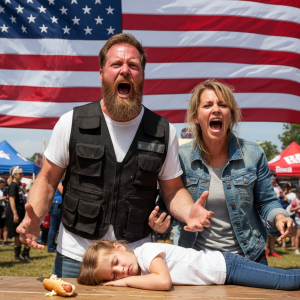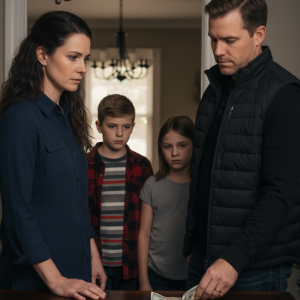None of us saw him arrive; suddenly he was just there.
He stood beside the car, tears shaking his tiny shoulders. No shoes, sun‑pink skin on his neck, little hands white‑knuckled around the door handle as though sheer will might spring the lock.
I glanced around. No panicked parents, no frantic shouts. Just afternoon sun and distant traffic.
I crouched. “Hey, buddy—where are Mom or Dad?”
His sobs grew louder. “I wanna go back in!”
“In where?” I whispered.
He jabbed a finger at the car. “The movie! I wanna go back in the movie!”
I tried the handle—locked. Peered inside. No car seat, no toys, nothing that said child rides here.
Thinking he meant the cinema down the block, I lifted him and headed that way. “Did you come here with someone?”
He nodded. “My other dad.”
That stopped me. “Other dad?”
He nodded again. “The one who doesn’t talk with his mouth.”
Before I could untangle that, a mall‑security officer rolled up in his golf cart. I told him everything as we toured the food court, the play zone, the security office. Every parent we approached shook their heads: “Sorry, not mine.”
Surveillance footage was queued. That’s where normal ended.
Frame one: nothing. Frame two: a barefoot boy next to the sedan. But his shadow? Its hand reached sideways, clasping… air.
“Some kind of prank?” the guard muttered.
The child—quiet now—nestled against my shoulder. “What’s your name, kiddo?”
He breathed the syllables “Eli… maybe Elias.”
Police were called. Hospital next. Protocol. Yet protocol felt paper‑thin against whatever this was.
I left my number and drove home, certain the story had ended. It hadn’t.
Tap, tap, tap. Two nights later, 2 a.m., at my bedroom window.
There he was—same yellow shirt, bare feet damp with lawn water.
I rushed outside. “Eli, how did you get here?”
He pressed a warm toy car into my palm. “I don’t like the hospital. They won’t let me talk to Dad.”
“Which dad?” I asked, though I already knew.
“The quiet one.”
Police arrived—stunned. Eli had vanished from a monitored hospital wing; doors never opened, cameras never blinked.
An officer whispered later: they’d seen a case like this before—a child naming “the dad who talks without a mouth,” disappearing twice.
I scoured newspapers, forums, missing‑child bulletins. Patterns emerged: children materializing barefoot, mentioning silent parents, vanishing from locked rooms.
At the hospital the next day, staff stonewalled me. In the corridor a janitor murmured, “That boy’s not lost—he’s looking.” Then rolled away, bleach smell trailing behind.
Three nights later, laughter floated down my hallway. Eli sat cross‑legged, building a castle of stacked books.
“He brought me back. Wanted you to see,” he said. See what?
I tucked the drawing into my wallet, a talisman against rational doubt.
A week later Eli vanished while tossing a ball to the neighbor’s dog. Only the metal car remained on the step.
Strangely, I felt calm. He was part of something larger—an unseen migration from pain toward safety.
I began volunteering at a youth shelter, waiting.
Six months on, it happened: Sophie, six, barefoot under an overpass, clutching a wilted sunflower and a key with no lock. “My mirror daddy left me here,” she said. She shared Eli’s wide, watchful eyes.
She pointed at Eli’s drawing. “He hums like a refrigerator,” she whispered of the faceless figure.
Now the guest room is always ready—sheets crisp, fruit bowl full. I don’t interrogate. I listen.
Because sometimes “missing” isn’t about being lost; it’s about being delivered—to someone willing to guard a fragile moment of peace.
If you see a barefoot child crying alone, don’t look away. Your doorstep may be the waypoint they’re meant to reach.
Did this story move you? Tap “like,” share it, and tell us—have you ever crossed paths with a child who seemed to step out of nowhere?





